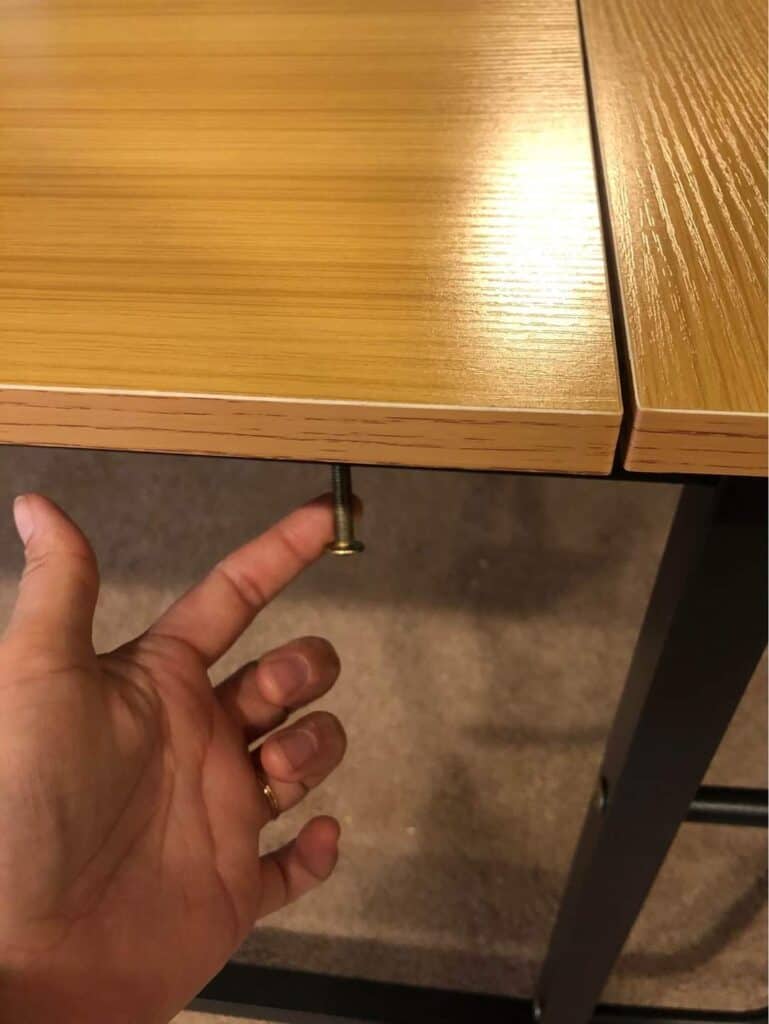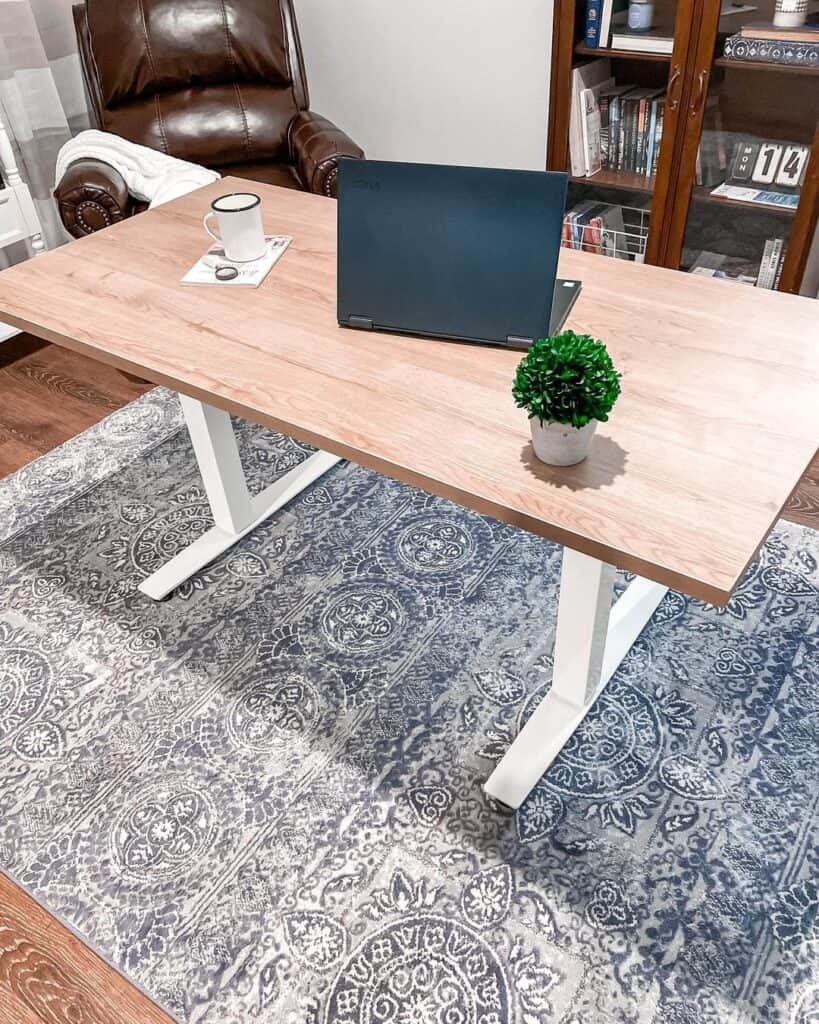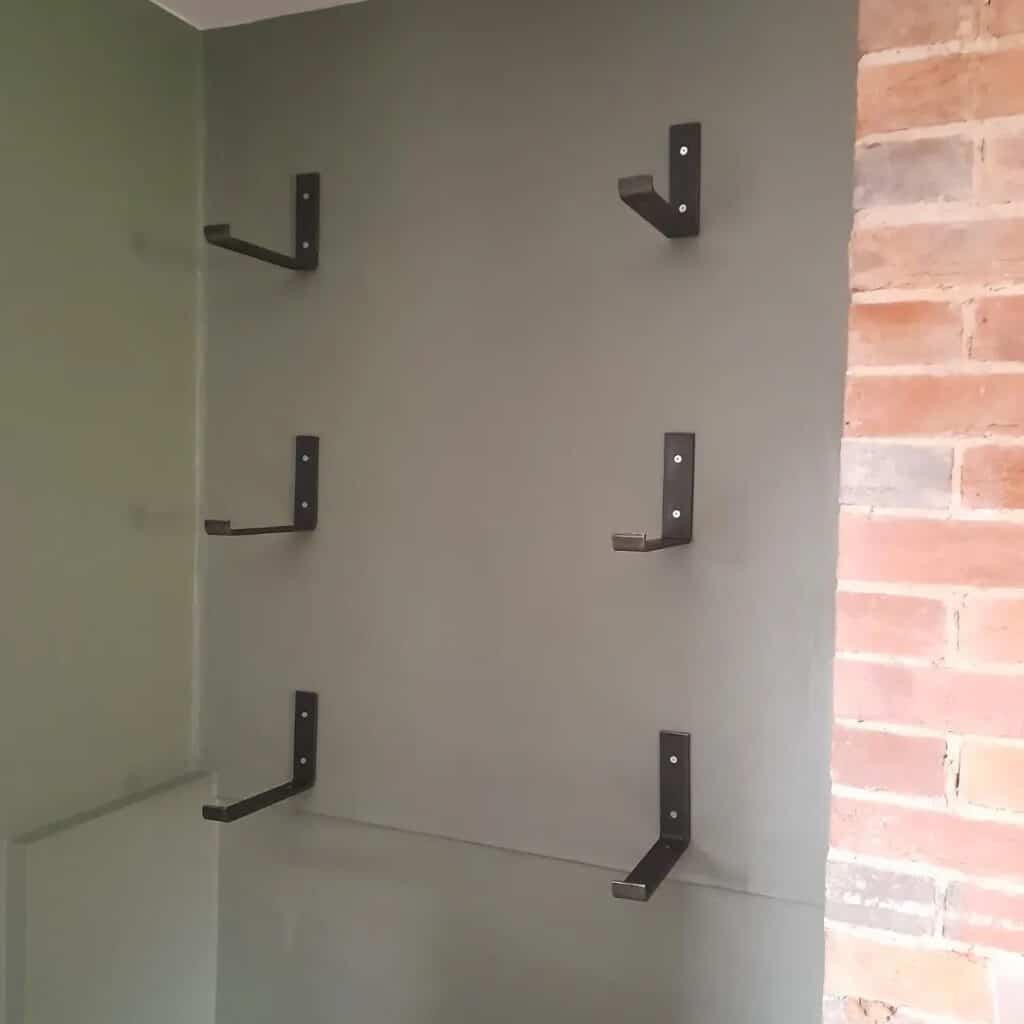Standing desks are great for your posture. However, they can wobble on the carpet, which I find very distracting.
I used a bunch of folded papers to make my standing desk stable. However, there are many ways to prevent standing desk wobble.
Standing and sitting desks are both found in various materials and serve the same function. But why do standing desks have increasing wobble issues with time?
The answer is its framework design, shape, adjustability, and support systems described in detail in the article.
Read on to find out ways to stabilize your standing desk.
Table of Contents Show
Why Does my Standing Desk Keep Wobbling on Carpet?
Your standing desk may be wobbly for two reasons; either there is an issue with your desk, or there is an issue with the carpeting and flooring.
Here are a few possible causes of your standing desk wobbling on the carpet.
1. Uneven Desk Legs
Uneven desk legs are more likely due to manufacturing errors. Or, if you have built the desk yourself, it may be a measurement error.
Either way, when one or more of the four legs in your standing desk is uneven, your desk will move when you work on it.
2. Loose Screws or Bolts
Another reason your standing desk is wobbly might be because it came assembled with loose bolts or if you did not tighten the bolts yourself while building your standing desk.
Likewise, when you use the desk for a long time, the screws and bolts might be loose.

Some cheaper standing desks do not have adhesives like Loctite used on the bolts to ensure their tightness.
The natural vibrations caused by the movement of the desks can cause the screws to loosen up over time.
The problem of loose bolts and screws mainly occurs in metal-framed standing desks.
3. Too Many Moving Parts
Standing desks now have many adjustable features like height adjustment, compatibility, etc.
However, the increase in moving parts can also make the desk wobbly as bolts create more weak points for the frame.
For example, a regular sitting desk with no adjustability features would only have screws and bolts on support points like cross support or under the desk’s top.
However, a standing desk with moving parts will have bolts in the middle of the desk legs when extended.
This can cause the bolts to loosen faster as the vibration along the legs is more than near the surface.
4. Lack of Cross Support
Standing desks usually have a T-based design with upper cross support near the desktop rather than the traditional cross support for aesthetics and knee clearance.
However, when the desk’s height is increased, the cross support is further from the ground, making it more wobbly.
5. Uneven Items Distribution
Your desk might be wobbly due to the uneven distribution of stuff on the tabletop.
For instance, you might have a pile of books stacked on one desk corner. This can cause the table to lose balance and wobble.
Moreover, it is possible for a tall standing desk to cause wobbling if it is not correctly constructed or balanced.
Due to their height, any movement at the upper surface provides a greater leverage force than the feet. As a result, taller desks are more unstable.
Read on to discover more about the right-sized standing desk for you.
6. Use of Non-specific Glides
Glides are used mainly in adjustable standing desk frames to attach the metal columns with no friction. For proper stability, custom-fit glides are required.
However, low-cost desks use one size that fits all glides, making your desk unstable.
Glides are placed on the top and bottom of the column. However, some brands have them placed only on top, creating gaps between columns leading to wobbling.
7. Soft Plushy Carpet
Soft and plushy carpet with high piles is uneven surfaces that can cause your desk to wobble when placed on it.
Use a flat carpet with a low pile for more stability.
8. Uneven Carpets or Floor
Your standing desk might be wobbling because of the uneven flooring. This can cause your desk to tilt or move when working.
If non of the above reasons apply to you, try shifting the desk to a different place in the room.
Over time debris can build up below the carpets or chair mats which can cause bumps and uneven surfaces, leading to wobbling to fix that,
find the best office chair mat alternatives

How to Fix Standing Desk Wobbling on Carpet?
Standing desks are more likely to wobble. But you can stop it from wobbling by using accessories like standing desk mats, stabilizers, or alterations like sawing off the legs.
1. Use a Standing Desk Mat or Chair Mat
Standing desk mats are used for standing desks to prevent fatigue. However, they can also provide a solid surface for your standing desk.
Standing desk mats or chair mats offer a smoother surface to place your desks on, which will cause your desk to be stable.

For example, if you have a high pile of carpet, the surface is unsuitable for your desk, but your desk is stable if you place a chair mat above it.
You can use them over your carpets or rugs.
Read More: Do Chair Mats Damage Hardwood Floors?
2. Use a Leveler
Use the leveler on the shorter leg of the desk.
Place wooden blocks or any sturdy material non-flexible material between the desk legs and the carpeted floor as stabilizing blocks.
Glue a wooden block or penny to the shorter leg for a more permanent fix.
You can also purchase levelers from Amazon and screw them on your desk legs.
3. Fix Unbalanced Legs
You can also trim down the longer legs of the desk if you want to shorten the total height.
Take a hand saw and saw it off after measuring all legs. Or, get a professional to see it off.
The best part about desk risers is that they add height to the desk and aid in widening and stabilizing its footprint. They provide stability by dividing the load across the floor.
4. Tighten the Bolts and Screws
Prolonged use of desks can loosen the bolts. So, you must check and tighten the bolts every six to twelve months.
Follow these simple steps;
- Flip the desk upside down.
- Check if there are any—loose screws or bolts.
- Use a screwdriver and tighten the bolts.
- You can also use wooden glue for this purpose.
- Add washers into each loosening frame to make it more stable.
5. Choose a Right Framed Standing Desk
If you are taller and require more knee space, choose a C-based design with more stability with 24 to 30 inches of desk height.
Desks without a wedge system are not as stable as desks with a wedge system. You can get the best lateral stability by using a standing desk with a wedge system.
Read on to discover about the best way to Choose the Standing Desk Frame.
6. Install Cross Support
Traditional cross-support may not be included with your standard standing desk. You can install the support yourself.
You can use a wooden board or metal bracket to the back of the desk. If you have an electronic standing desk, you must ensure the installation does not affect its mechanisms.
Standing desks with anti-wobble cross support eliminate wobbling. The positioning of the cross support reduces any wobble while raising the work surface.
The design also helps to minimize lateral movement, resulting in a wobble-free desk at any height.
The cross support shortens the legs’ effective length and forces them to remain parallel.
7. Install Glides
- Flip the desk upside down.
- Hammer the glide into the tacks.
- Make use of pressure pads if the tacks have them.
- They are suitable for measuring the gap between the desk leg and the floor.
8. Use L Brackets
- Place the L brackets where you want to place the brackets and mark where the holes are.
- Screw the L brackets into place by using a screwdriver or electric drill.
- Install the L brackets near the top of the legs towards the surface rather than at the bottom to stabilize the desk.

9. Relocate your Standing Desk
If none of the above methods work, move your desk to a different location in your room or change its position.
Sometimes, the floor level can be uneven, causing the furniture to wobble around.
Tips to Prevent Standing Desk Wobbling on Carpet
Here are some more tips on preventing the standing desk from wobbling.
- Choose a low pile carpet to provide a solid ground for a standing desk.
- Clean the floor and under the carpets frequently to prevent debris build-up and the desk legs, which can cause your desk to wobble.
- Suppose you are assembling the desk by yourself. You need to use adhesives like Loctite on the bolts to ensure they remain tight.
- To distribute the weight evenly on your desk’s top, declutter your workspace and do not pile stuff on one corner of the desk.
- Use shelves or other storage options to keep your desk free of weight.
- You can also use felt pads or rubber feet to stabilize your desk.
- You can use carpet spikes on the bottom side of your carpet to make the surface even. It helps to make desk more stable on the carpet.
Also read:
Top Steady Standing Desks for Carpeted Floor in 2026
Here are some of the best standing desks with stability tested through a wobble meter.
A Wobble meter is a stability test done on desks to test their rocking motion.
| Standing Desk | Features | Product Image |
|---|---|---|
| Vari Electric Standing Desk | Wobblemeter Score: 132 T-Style legs for enhanced stability 4 programmable memory settings |  |
| VertDesk v3 | Wobblemeter Score: 116 Voice Control gyro sensors Standard lifting capacity of 275 lbs |  |
| UPLIFT Desk - V2-Commercial Height Adjustable Standing Desk | Wobblemeter Score: 132 Height adjustment 355 pound lifting capacity Advanced Digital Memory Keypad |  |
| NewHeights XT | Wobblemeter Score: 82 Includes Cross support Lifting capacity of 325 lbs |  |
The Bottom Line
Standing desks can wobble due to their structure. However, they are worth it due to the postural benefits.
Moreover, your standing desk can wobble due to its frame, loose screws, lack of cross support, etc.
You can prevent your desk from wobbling using a lever, L brackets, Glides, etc.
Also read: Choosing the Right Standing Desk Frame: A Complete Guide


